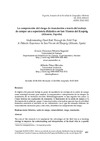Identificador persistente para citar o vincular este elemento:
https://accedacris.ulpgc.es/jspui/handle/10553/54013
| Campo DC | Valor | idioma |
|---|---|---|
| dc.contributor.author | Morote Seguido, Álvaro-Francisco | en_US |
| dc.contributor.author | Pérez Morales, Alfredo | en_US |
| dc.date.accessioned | 2019-02-05T14:20:27Z | - |
| dc.date.available | 2019-02-05T14:20:27Z | - |
| dc.date.issued | 2019 | en_US |
| dc.identifier.issn | 1133-598X | en_US |
| dc.identifier.uri | https://accedacris.ulpgc.es/handle/10553/54013 | - |
| dc.description.abstract | El objetivo del presente trabajo es poner de manifiesto las ventajas de la salida de campo como estrategia docente para mejorar la comprensión e interpretación de los riesgos de inundación de un territorio concreto. Metodológicamente se han seguido tres pasos: 1) Clases teóricas con explicación de conceptos; 2) Realización de la salida de campo; y 3) Evaluación de la salida de campo. Como conclusión, cabe indicar que este tipo de actividad formativa convierte al territorio en un «laboratorio» en el que los alumnos obtienen los conocimientos necesarios para, entre otros, identificar los componentes del riesgo. | en_US |
| dc.description.abstract | The aim of this research is to emphasize the advantages of the field trip as a teaching strategy to improve the understanding and interpretation of the flood risks in a specific area. Methodologically, three steps have been followed: 1) Theoretical classes with explanation of concepts; 2) Realization of the field work; and 3) Evaluation of the field work. In conclusion, this type of training activity makes the territory a “laboratory” in which students obtain the necessary knowledge, among other things, to identify the components of risk. | en_US |
| dc.language | spa | en_US |
| dc.relation.ispartof | Vegueta: Anuario de la Facultad de Geografía e Historia | en_US |
| dc.source | Vegueta: Anuario de la Facultad de Geografía e Historia [eISSN: 2341-1112], n. 19, p. 609-631 | en_US |
| dc.subject | 55 Historia | en_US |
| dc.subject.other | Didáctica | en_US |
| dc.subject.other | Salida de campo | en_US |
| dc.subject.other | Vulnerabilidad | en_US |
| dc.subject.other | Riesgo | en_US |
| dc.subject.other | Inundación | en_US |
| dc.subject.other | Didactics | en_US |
| dc.subject.other | Field Work | en_US |
| dc.title | La comprensión del riesgo de inundación a través del trabajo de campo: una experiencia didáctica en San Vicente del Raspeig (Alicante, España) | en_US |
| dc.title.alternative | Understanding flood risk through the field trip: a didactic experience in San Vicente del Raspeig (Alicante, Spain) | en_US |
| dc.type | info:eu-repo/semantics/article | es |
| dc.type | Article | es |
| dc.identifier.eissn | 2341-1112 | - |
| dc.investigacion | Artes y Humanidades | en_US |
| dc.type2 | Artículo | en_US |
| dc.identifier.ulpgc | Sí | es |
| dc.description.esci | ESCI | |
| dc.description.fecytq | Q3 | |
| dc.description.fecytpuntuacion | 35,24 | |
| dc.description.dialnetimpact | 0,0 | |
| dc.description.dialnetq | Q2 | |
| dc.description.dialnetd | D3 | |
| dc.description.erihplus | ERIH PLUS | |
| item.fulltext | Con texto completo | - |
| item.grantfulltext | open | - |
| Colección: | Artículos | |
Visitas
651
actualizado el 11-ene-2025
Descargas
1.325
actualizado el 11-ene-2025
Google ScholarTM
Verifica
Comparte
Exporta metadatos
Los elementos en ULPGC accedaCRIS están protegidos por derechos de autor con todos los derechos reservados, a menos que se indique lo contrario.
